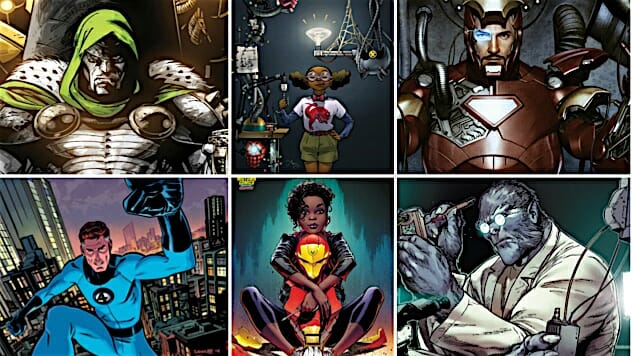Science Is a Superpower… If You’re a Boy.
Images Courtesy Marvel Comics
“Who’s that?”
My daughter is watching me play Marvel Puzzle Quest, a gem-matching game for mobile devices featuring Marvel Comics superheroes. She may just be six, but thanks to having a dad whose childhood love of comic books has left a permanent mark, she probably knows her superheroes—Marvel and DC—better than most.
“That’s Mr. Fantastic,” I explain. (Hey, I’ve kept everyone in my family as far away from the film versions of Marvel’s first family as possible. Can you blame me?)
“What are his powers?” she asks.
“Well, he can stretch into pretty much any shape, and he’s a very smart scientist, so he can also invent things to solve problems or defeat enemies.”
My daughter files this information away.
“And that’s Black Panther?” (I’ve totally let her watch Captain America: Civil War.)
“Yep! He actually first appeared in the same comic book with Mr. Fantastic, and has been a member of the team—”
“What are his superpowers?” My daughter is not interested in trivial things.
“Well, he has the powers of a panther, so he’s super fast, strong and agile. He’s also the king of a country.” I pause for a second. “He’s also a very smart scientist.”
Satisfied she had filled in the necessary gaps to her knowledge, she turns her attention to drawing a new Pokémon. I thought about her questions (and my answers). For all the gaudier displays of extranormal abilities in comic books—flying, superstrength, etc.—there are definitely some less “super” but just as important abilities. Being filthy rich is probably the most recognized of these. Plenty of jokes have been made about how being a billionaire comes in handy if you’re a costumed vigilante, but the more I thought about it, wasn’t being a super-intelligent scientist an even more frequently relied upon “bonus” crutch for comic book writers?
I looked at the roster of heroes on the MPQ app. In addition to Mr. Fantastic and Black Panther, there’s Iron Man. The Hulk. Beast. Spider-Man. These are all heroes who, in addition to having a distinct power set, also happen to be brilliant scientists. (Granted, with someone like Iron Man, his armor is the result of said brilliant mind.) Looking on the villain’s side of the ledger, it’s the same: Dr. Doom is a king, a sorcerer and so brilliant he’s even invented a time machine. Green Goblin. Dr. Octopus. Even moving outside of the characters featured in MPQ, there are whole B- and C-tiers of villains who possess the “super smart in science” power set either as their primary or as a “bonus” attribute. There is Mister Sinister, the Wizard, the High Evolutionary and the Mad Thinker. The Tinkerer, the Leader, MODOK and the Red Ghost.

MODOK., Egghead, Red Ghost, the Mad Thinker, the Leader, the Wizard, the High Evolutionary, Mister Sinister. Seriously, every other B-list male villain has mad science skillz.
And there are plenty of other heroes who fit the bill, including the original Ant-Man/Yellowjacket (Hank Pym), Forge, Amadeus Cho, etc. In Marvel Comics, there’s no shortage of men either solving problems or causing them with intellect and science.
But if you’re looking for a female superhero or villain who uses her intellect in general and science in particular to reach heroic heights or further nefarious ends? Well, the options are less copious.
Scientifically endowed female superheroes (or as I like to think of them, potential role models) are absurdly scarce in the Marvel universe. Moira MacTaggert is definitely a scientist, but she’s not a superhero. Kitty Pride had that go-to science-flavored ability of the 1980s—hacking—but though she’s officially genius-level, good luck catching her using that portion of her intellect. And despite a lab coat or two in the dreadful film versions, comic book Sue Richards, a.k.a. The Invisible Girl/Woman, just has an unspecified doctorate in… something.
No, with the exception of Sage, an obscure mutant from the X-Men’s corner of the universe you either never knew or had forgotten about until I just said her name, there are basically just four characters for whom science is an active part of their super-makeup—and spoiler, none of them is very well-known: Valeria Richards, the daughter of Mr. Fantastic and the Invisible Woman, who made her first appearance in 1999; Riri Williams/Ironheart, who debuted in May 2016; Lunella Lafayette/Moon Girl, who made her first appearance in January 2016; and Nadia van Dyne, who first appeared in May—you guessed it—2016.
But think about that. For the first 55 years of Marvel’s existence, Stan Lee and company, in all their flights of fancy, barely managed to create one superpowered female who happened to be a kick-ass scientist, too. And in my 45 years or so of ingesting even the most ludicrous storylines to the point I know them better than most aspects of my own family history, I never noticed that the science lab was boys only, be you a hero or a villain. Maybe Valeria, Riri, Lunella and Nadia mean that’s finally changing. Tune in five to ten years from now and we’ll see where these characters are. (Moon Girl’s also part of a package deal along with Devil Dinosaur.)
Are there smart women in the Marvel Universe? Certainly. There are countless examples of female heroes and villains using their wiles and sex appeal and tactical smarts to complement their bona fide superpowers. But costumed heroines who also use science to solve their problems? Apparently, that’s too fantastic.
So where does that leave a father and his six-year-old daughter? After all, it’s not really that surprising that a medium whose business, for decades, has revolved around catering to the adolescent fantasies of young boys (and later, young men) would not be that good at catering to the hopes and dreams of its female fans.
It is a problem, though, that as the medium has matured, its representations of what female characters can do has not.
What Do You Want to Be When You Grow Up?
As someone who started collecting comics when I was five, it’s not surprising that from early on my stock answer to the question, “What do you want to be when you grow up?” was simple: “A superhero.” (I also fulfilled the contractual obligation every kid apparently has by wanting to be a marine biologist for a few years.) Honestly, that’s still my real answer to that question, even as I’ve found other lines of work that don’t require as much exposure to gamma rays, chompy radioactive spiders or the active intrusion of the Asgardian mythos.
My problem with the lack of sharp, female scientists (who can also fly, fire energy beams from their eyes, etc.) lies not in any objection to the ludicrous, fantastic and, admit it, totally cool stuff the characters can do beyond the scope of us normals. The fantasy is fine; it’s the simple, effective, decades-blanketing denial of reality that’s hard to stomach. Among what has to be the most expansive, completely impossible list of things you can do—talk to squirrels, change shapes, teleport, control magnetism!—there’s also one thing a woman implicitly does not do, and it happens to be something so many women have done well. As a father, it especially bothers me because it’s the very same kind of “negative space” lurking everywhere for young girls at play. It’s there for the girl who gets a “doll” that looks a certain way while her brother gets an “action figure” that does something cool. It’s there with the Disney princesses (no matter how much reclamation is attempted). It’s there in practically every single commercial aimed toward women (and half of the ones aimed toward men).
Sure, science allows writers to wiggle their characters out of tight situations, but better still, science is a superpower, and all the more powerful because it is a mundane one. Real-world science saves lives (and takes them). Scientists discover things that transform societies (for better and for worse). And while our children won’t ever be able to shrink to the size of an atom or toss cars around with the power of their minds, they can be scientists.
Yet why, after more than a half century of stories told by countless writers and artists, do I just need one hand to count the number of female characters who qualify? Marvel can do better.
All Hail Ret-Con the Magnificent?
Valeria, Riri, Lunella and Nadia are a start, but ultimately no amount of newly introduced characters—two of whom are replacing/standing in for male predecessors—will overtake the already established ones. Yet in a medium that tinkers with its core characters’ origins more than any branch of entertainment outside of professional wrestling, how difficult would it be to redefine one or two of those iconic female heroes into someone who practices some mean science? Janet van Dyne (Wasp) is a founding member of the Avengers. It’s already established her father was a scientist. Perhaps it’s time to leave her fashion designer/debutante beginnings in the 1960s along with all the other embarrassingly dated depictions of “silly girls” Stan Lee and company seemed so fond of? Give Kitty Pryde a seat at the “big brains” table by expanding the importance and extent of her (science) powers. (Jennifer Walters/She-Hulk is a lawyer—in the 1980s, women were allowed to enter the legal profession in comic books—so she’s fine.) And just as importantly, there are all the B- and C-tiers on both sides of the heroic spectrum— Heather Hudson, Hellcat and Firestar. Madame Masque and Callisto.
Of course, a sprinkle of ret-con, sustained attention to the small group of existing characters, and the continued creation of new ones won’t solve all Marvel’s woes overnight, but it would be a good start at reaching a new status quo. After all, among all the tales of the fantastic, young readers of comic books (male and female alike) are ingesting representations of the matter-of-fact and the mundane as well, and for girls just as much as boys, science is a superpower.
Michael Burgin is Movies Editor for Paste. He’d rather be a costumed vigilante.







































